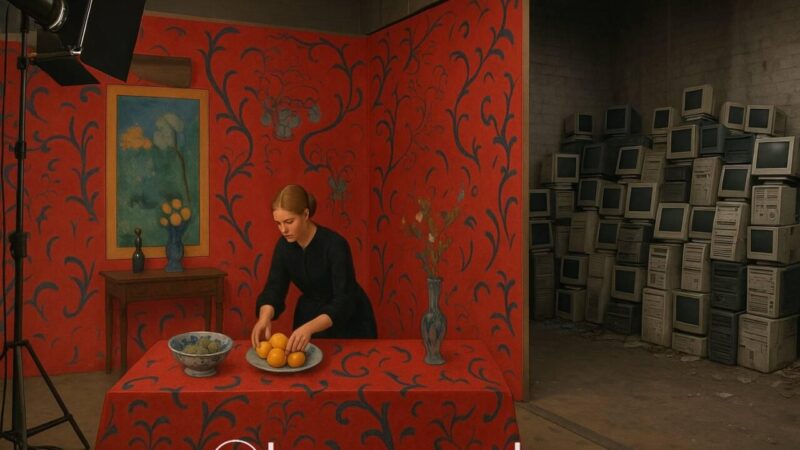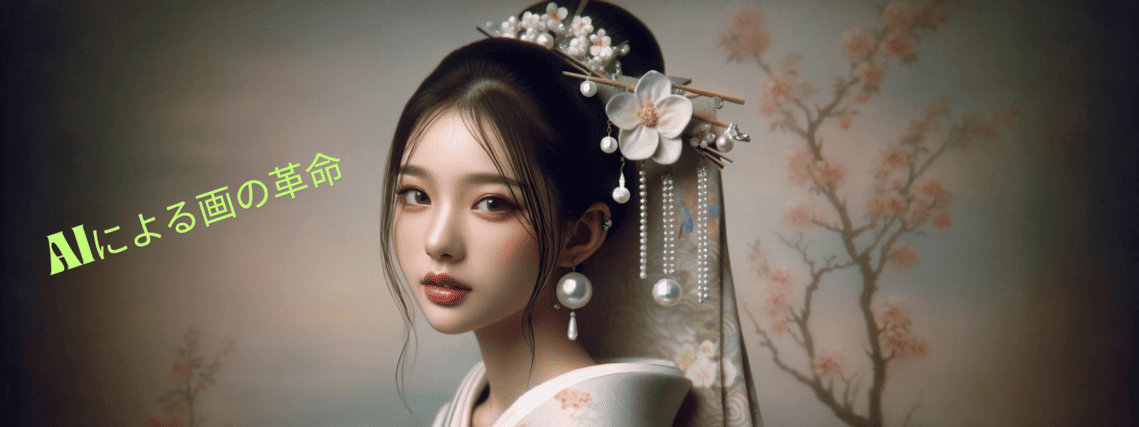広告

Blazing red arabesques flood the room, while towers of obsolete CRT monitors loom in the background like piles of rubble.
Early-20th-century Fauvism collides with the digital detritus of the 1990s: what kind of narrative does the canvas begin to spin?
This post unpacks a bold re-interpretation of Henri Matisse’s “Harmony in Red” (The Red Room, 1908), seen through the dual lens of an art critic and — behind the curtain — an accomplished forger.
1. First Impressions
The eye is instantly caught by the red-and-indigo vine pattern that dominates every surface.
Amid this decorative frenzy, a woman in black arranges citrus fruit with the poise of an actor, breathing life into the still life.
A studio spotlight creeps into the upper left; in the back right, dusty CRTs are stacked like architectural bricks.
Painting versus photography, a 19-century parlour versus industrial waste — two eras crash together in a hectic yet curiously magnetic scene.
2. Tracing the Original Masterpiece
Title, Artist, Year
- Title: “Harmony in Red” (The Red Room)
- Artist: Henri Matisse
- Year: 1908
Historical Context
Labeled a “wild beast” at the 1905 Salon d’Automne, Matisse pursued pure colour and ornamental power with uncompromising zeal.
“Harmony in Red” — first painted blue, then repainted red at the patron’s request — is often cited as a proto-all-over painting in which colour itself governs the space. Background and tablecloth share the same motif, stitching room and furniture into a single plane that defies perspective.
Signature Features
- Total‐pattern ornamentation — swirling vegetal lines bind the scene together.
- One dominant hue — the overwhelming reign of red.
- Flattened perspective — the tabletop merges with the wall, unsettling depth cues.
- Still life + figure — fruit bowl, vase and maid enact a tiny stage play.
3. Keys to the Re-interpretation
- Revealing the backstage: the spotlight declares the set as a film stage, adding a modern meta-layer.
- Digital ruins: the CRT mountain evokes late-20th-century throw-away culture, counter-pointing lush ornament with dead tech.
- Chromatic retuning: the poppy red of 1908 shifts to a slightly smoky vermilion, like velvet under warehouse lighting.
- Stance of the figure: clad in black, she reads more researcher than maid, as if calibrating the fruit for an experiment.
- Extending the table: the motif rolls from cloth to wall, yet a angled back wall sneaks volume back in — a clever tweak.
4. Analysis — Questions Raised
Matisse sought “happiness through colour alone.”
This piece transplants that theatre of happiness into a graveyard of worn-out technology.
In our age of mass-production and mass-disposal, the red décor becomes the husk of a “beauty already consumed”, while the woman’s gesture reads as a rite of “preservation and re-placement” that bursts beyond the canvas.
The exposed spotlight — an outside eye — inserts documentary distance against Fauvist intuition, forcing viewers to ask: “Is beauty ornament, record, or nostalgia amid the ruins?”
5. Critical Wrap-up
By grafting the “unwanted” relics of the digital era onto Matisse’s colour-drunk original, this reboot stages a daring reconstruction.
Reintroducing shards of perspective banned by Matisse, the interpreter underscores the threshold between décor and reality — a “new romance of preservation” haunting the culture of waste.
Forger’s eye: tiny disruptions in the brush pattern and a warehouse-dampened palette betray meticulous calculation.
Exultant colour meets the shadow of industrial refuse — a tour de force that nails this double bind in a single frame.
